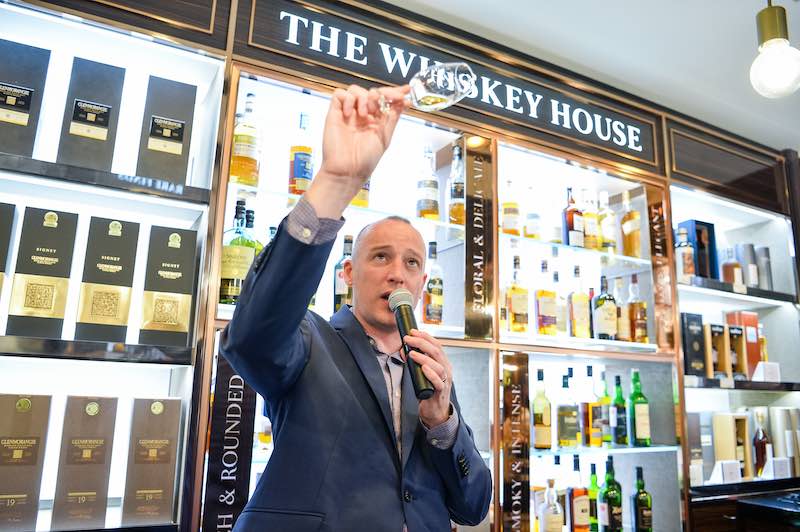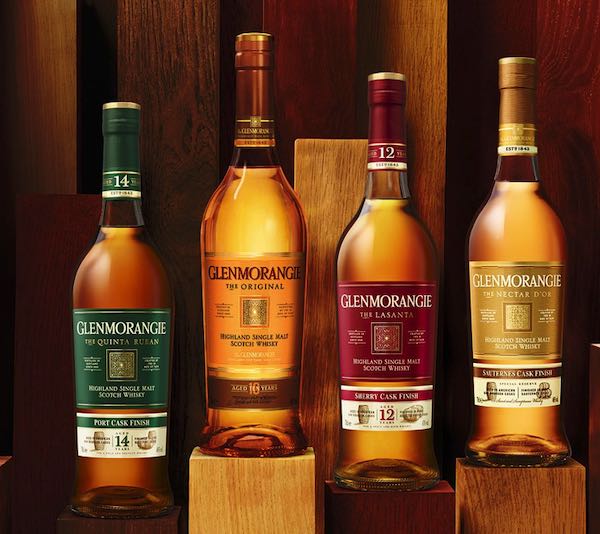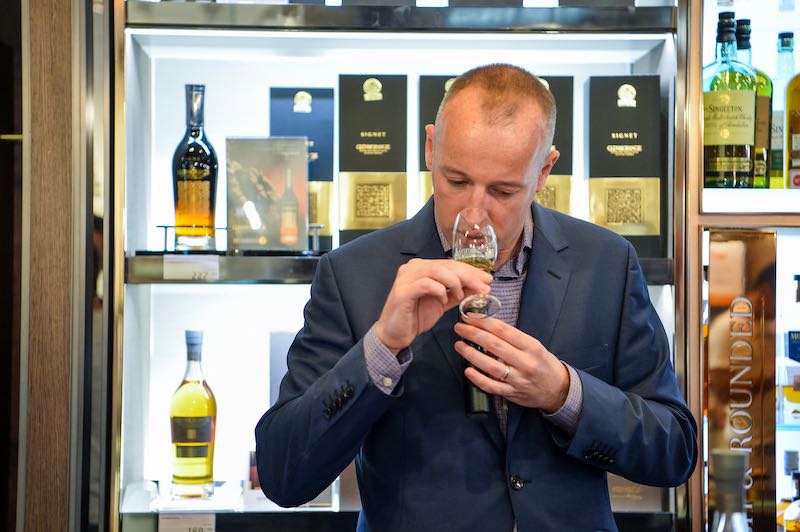A Chat with Brendan McCarron from Glenmorangie

Brendan McCarron, Head of Maturing Whisky Stocks at The Glenmorangie Company
WhiskyGeeks is fortunate to get a chance to speak with Brendan McCarron, the Head of Maturing Whisky Stocks at the Glenmorangie Company, during our DFS event. As the heir apparent to whisky legend, Dr Bill Lumsen, Brendan has plenty to work on. He joins the company five years ago and started work with the whisky creation team alongside Dr Bill.
Brendan’s Whisky History
Brendan hails from Glasgow, Scotland. As a chemical engineering graduate, he started his career in the whisky industry in 2006 when he joined Diageo. After three years, Brendan began work as the distillery manager at Oban. Two years later, he left for “Peatland” – Islay, where he worked with Lagavulin, Caol Ila and of course, Port Ellen.
Port Ellen is a malting facility where Brendan got to work with the maltsers on different requirements. Making smoky malted barley was probably one of his favourite thing to do! The smoky malted barley was also the reason that Brendan got to know Dr Bill Lumsen. After ten years of working as a distillery manager, Brendan decided to change his direction and joined The Glenmorangie Company as part of their whisky creation team.
Brendan’s Unique Journey
Brendan has a fantastic whisky journey from the day he joined the industry in 2006. He is probably one of the very few people in Scotland who has worked on all aspects of whisky making. From designing a brand-new distillery (building it!) to malting, distilling and maturing whisky, Brendan has done it all. These experiences at the various distilleries and malting houses have shaped Brendan’s knowledge and expertise along the way. Additionally, he also went out of his way to acquire theoretical knowledge through his pursuit of books, courses and degrees. All of these add to his practical experience and give him a well-rounded education in whisky making.
Glenmorangie and its whiskies

Glenmorangie Whiskies (Picture Credit: Glenmorangie.com)
We had a short chat with Brendan on the different exciting whiskies that are coming shortly. We understood that there is a 25-year-old whisky released, but so far, we have yet to see it land in Singapore. It may be soon, but we do not know when.
The exciting part of the chat is, of course, the single cask #1399, that we tasted during the DFS tie-up event that we did on 22 June 2019. It is part of their latest project to launch exclusive single casks for specific countries. Making its debut as a travel retail exclusive bottle is naturally the best way for a brand to market a rare single cask bottling in Singapore considering the sheer volume of people passing through our airport!
Glenmorangie’s Affairs with Wood
Wood has always been the talk for Glenmorangie. We know that they used exceptional “designer” oak casks for some of their limited edition whiskies. We asked Brendan about these casks.
The creative team at the distillery involves itself in the creation of the oak casks from the start. Their research led them to the Ozark Mountains of Missouri, USA, where they found slow-growing wood that suits the spirit of Glenmorangie. To bring the effects of the slow-growth wood further, the team discovered the trees in the Mark Twain National Forest, where the oak trees grow slowly and develop the porous nature that the Glenmorangie team needs for its whiskies.
The Making of Artisan American White Oak Casks

An Oak Cask (Photo Credit: Glenmorangie.com)
The entire process of making these oak casks started with the identification of specific trees within the Mark Twain National Forest. These trees are cut and then air-dried for two years for maximum effects. Air-drying not only reduces astringency and improves the wood’s permeability; it also enhances the soft and rich flavours of the Glenmorangie whiskies.
These tight-grained but porous wood are then made into casks. The casks will be heavily toasted and then lighted charred for the distillery’s needs. The cooperage then fills bourbon whisky in the casks for precisely four years. It is like clockwork. Once four years is up, the casks are ready for shipment to the Scottish Highlands. The whole process takes six years to complete. Such dedication to oak casks is impressive, and we salute the team for going through with this process.
Designer Wood Casks for Limited Edition Whiskies
Some of the designer wood casks hold the core range of the whiskies from Glenmorangie; others hold limited edition whiskies. One of the famous limited edition is the Glenmorangie Astar. Our team got the chance to taste the Astar at another event held at The Exciseman on 1st July, where Brendan gave a presentation to both trade and consumer alike. We will speak of that another time.
Due to the higher porosity of the cask, the whisky soaks better into the wood, extracting flavours that the distillery is after. The distillery also uses these designer casks only twice for maturation purposes. Brendan explained that the casks are no longer suitable after two uses, and they usually sell the majority of these casks. Some get left behind for experiments, and a small number of them go to Ardbeg.
Are Flat-Packing Barrels still a Cost-Saving Practise?
We asked Brendan some essential financial questions as well, that affects production. In the past, some distilleries broke up the ex-bourbon barrels they bought and flat pack them before shipping to Scotland. Once the vessel landed, the distilleries brought the staves to a cooperage and rebuilt the casks. The practice affected the quality of the casks, and the whiskies matured in such casks become a debatable topic.
According to Brendan, this practice is hardly used in Scotland’s distilleries today. The discovery that they do not save cost by doing so was one of the significant factors. However, the debate on the practice that MAY have affected production was probably the main factor that led to the abolishment.
The abolishment, unfortunately, led to a reduction of hogshead as most hogsheads are rebuilt from standard barrels. While this is a loss to the whisky industry, we must remember that cost is always a factor for end-consumers because higher cost equates to higher prices!
The Truth about Virgin Oak Casks
Some distilleries are making use of virgin oak casks to mature some of their whiskies. We even know of new distilleries that make use of virgin oak maturation to reduce the number of years needed to produce delicious whisky. Glenmorangie uses virgin oak casks as well, and we wanted to know what Brendan thinks about them. He thinks, that virgin oak casks may prove to be too strong an influence on Glenmorangie’s new make spirits. The virgin oak casks may hide the fruity notes of Glenmorangie and make it “un-Glenmorangie”. Brendan prefers to do finishes with virgin oak casks instead.
It is of interest to know that Glenmorangie does a lot of wood finishes to bring flavours to their whiskies. For example, the distillery finished the Lasanta in Oloroso and PX sherry cask, the Quinta Ruban in Ruby Port Pipes and the Nectar D’òr in Sauternes casks.
Factors that Affects the Choices of Cask Finishes
Brendan explained that they do not know all the elements of influences when the creative team chooses the cask finishes. They know for a fact that the spirit of Glenmorangie works well with Port and Sauternes casks finishes. Unfortunately, they do not know the reaction to all the casks in the world. Therefore, it is much of a trial and error for the team when they are choosing the cask finishes. By selecting items of interest which the team thinks would work with the spirit, they came up with various experiments of different finishing casks. The availability of the casks is also crucial, as they need enough casks to complete a new finishing experiment.
Brendan mentioned that the team also takes the opportunity when it comes knocking. If their suppliers offer casks which they have not tried before, they may take a few of the casks to create new experiments. Some experiments will succeed while others may not. Part of the fun is finding out if it works. For those of you who are curious, the casks that don’t work are not thrown away! The team reracks the “unworkable” casks into sherry or ex-bourbon casks to “reset” them. Usually, the age of the whisky will also help to rectify any issues that the team finds.
Brendan Wants YOU to Know This!

Brendan, the whisky expert
We thought that we have enough technical talk, so we asked Brendan what the one thing that he would like the whisky community to know is. The answer is not surprising. Brendan wants everyone to know that a single malt whisky comes from a SINGLE whisky distillery. It is one of the most misunderstood terms in the whisky industry. Many whisky drinkers confused single malt whisky and single cask whisky. Brendan shares his frustrations at how he always get that same question – “How is the whisky still a single malt whisky when you blend all these casks to create it?”
To set the record straight, Brendan shares that a single malt whisky can be a “blend” of 15 casks from the SAME distillery. As long as the whisky is made from malted barley and is not blended with whisky from another distillery, it is a single malt whisky.
What You Can Do If You Want to Work for a Whisky Distillery
Most of our younger folks here would probably be keen to work for a whisky distillery. We ask Brendan what we need to do if we want to work for a distillery. Here is his advice.
Get a science-related degree if you want to be on the distilling team. Chemical engineering or chemistry is a good start. Otherwise, biochemistry is helpful too. There are, however, many ways to get involved. You can still work in the industry even if you have a business degree. You can join the distillery in sales or marketing with it. Nonetheless, you will still need the passion and love for whisky before you can comfortably stay in the industry.
Do not despair if you do not have any of those. Brendan said that having experience is equally vital if you are not Scottish and want to work in Scotland. He started in pharmaceutical and the knowledge he gained there translated into his next job with Diageo. Working in a brewery also helps because that involves two stages of the whisky distillation. Ultimately, the potential candidate needs to be open and adaptable. When you combine the passion for whisky and your openness to adapt, you will be able to make headway into the career that you want. Start with a job that you can do and learn from there. You will never know where that will take you!
